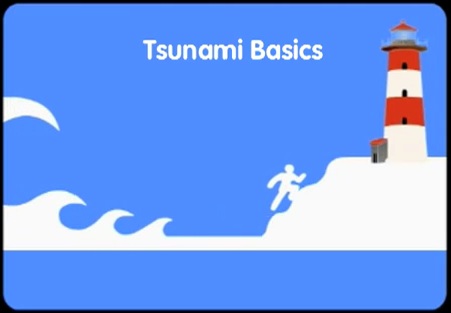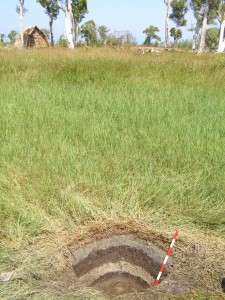Click Here for Information on the March 11, 2011 Tohoku Tsunami
Tsunami vs. Wind Wave:
 Tsunamis are often no higher than wind-driven beach waves but they are much more dangerous.
Tsunamis are often no higher than wind-driven beach waves but they are much more dangerous.
 Any time you feel a large earthquake, or see a disturbance in the ocean that might be a tsunami, head to high ground or inland.
Any time you feel a large earthquake, or see a disturbance in the ocean that might be a tsunami, head to high ground or inland.
Basic Reading – Surviving a Tsunami:
 Surviving a Tsunami – Lessons from Chile, Hawaii, and Japan (If you read nothing else, read this) This is a USGS publication (available online) that details how to survive a tsunami. It is based on personal accounts of the tsunami generated by the 1960 magnitude-9.5 earthquake in Chile. (url: http://pubs.usgs.gov/circ/c1187/)
Surviving a Tsunami – Lessons from Chile, Hawaii, and Japan (If you read nothing else, read this) This is a USGS publication (available online) that details how to survive a tsunami. It is based on personal accounts of the tsunami generated by the 1960 magnitude-9.5 earthquake in Chile. (url: http://pubs.usgs.gov/circ/c1187/)
Teaching and Training Materials:
 Tsunami Teacher USA Educational video that explains the basics of tsunamis and how to protect yourself. Although the video’s intended audience is the U.S. general public, much of the message is universal. We hope the video is useful for your future tsunami preparedness efforts. (url: http://www.youtube.com/watch?v=tUN_UTY0GNo0)
Tsunami Teacher USA Educational video that explains the basics of tsunamis and how to protect yourself. Although the video’s intended audience is the U.S. general public, much of the message is universal. We hope the video is useful for your future tsunami preparedness efforts. (url: http://www.youtube.com/watch?v=tUN_UTY0GNo0)
ITIC’s General Tsunami Info The International Tsunami Information Center (ITIC) summary page for educational and training materials. The ITIC is part of the Intergovernmental Oceanographic Commission (IOC) of the United Nations Educational, Scientific and Cultural Organization (UNESCO) (url: http://itic.ioc-unesco.org/index.php?option=com_content&view=category&layout=blog&id=2000&Itemid=2000&lang=en)
Tsunami Visualizations This page has links to visualizations of recent and historical tsunami episodes. They have also collected other materials about tsunamis that go beyond visualizations. (url: http://serc.carleton.edu/NAGTWorkshops/ocean/visualizations/tsunami.html)
Tsunami Research outside UW:
NOAA’s Center for Tsunami Research Part of the NOAA Pacific Marine Environmental Laboratory (PMEL), the center works in tsunami measurement technology and monitoring; forecasting and modeling of tsunamis and hazard analysis. (url: http://nctr.pmel.noaa.gov/)
U.S. Geological Survey Tsunami and Earthquake Research USGS research to identify places where tsunamis might be triggered, including offshore fault zones and areas prone to submarine landslides. Documentation of the geologic impacts of recent tsunamis. (url: http://walrus.wr.usgs.gov/tsunami/)
O.H. Hinsdale Wave Research Laboratory – Tsunami Wave Basin As part of George E. Brown Network for Earthquake Engineering Simulation(NEES) program, the Tsunami Basin is designed as a shared-use facility for next generation remote tsunami research (url: http://wave.oregonstate.edu/Facilities/Equipment/Tsunami_Wave_Basin/)
Tsunami! is hosted and maintained at the University of Washington by the Department of Earth and Space Sciences. This website is dedicated to providing general information about tsunamis and tsunami science as well as what to do in case of a tsunami.

 Jody Bourgeois—Paleotsunami Travels
Jody Bourgeois—Paleotsunami Travels Hig (Bretwood Higman) blogs about Alaska resources and other topics
Hig (Bretwood Higman) blogs about Alaska resources and other topics AGU Blogosphere
AGU Blogosphere